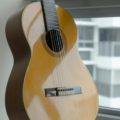Every so often, we decide to explore a new aspect of playing the guitar Strumming Practicing The Guitar - Practicing the guitar takes time and dedication. Learning to play the instrument requires consistent practice, but it doesn't guarantee that you'll become a rock star. Nonetheless, with regular practice and skill development, you can still achieve proficiency. There are two methods to start strumming a guitar: using your fingers or using a pick. Find a… that many people are either afraid of or simply have no idea about. Today, we’re going to tackle one of the more intimidating topics in guitar playing… Transposition.
Join us as we teach you the most simple and convenient methods to transpose your music.
Getting That Riff in Your Favorite Key!
How many times have you come up with a riff that you absolutely love, or discovered a song that you enjoy playing and wanted to incorporate it into a new, original piece? Chances are, we’ve all wanted to give it a try at least once or twice but always encountered one roadblock… Keys.
As mentioned in our previous post, the likelihood of two riffs being in the same key is low if you’re composing a lot of songs or aiming to connect two popular tunes together. This is where you need to transpose one of those riffs to link them together and place them within the same key.
Another scenario is when you’ve written an awesome riff that you envision fitting into one of your band’s songs… The only problem is that it’s in the wrong key! With transposition, you can still use that riff and play along with the rest of the band.
If you’re a true band nerd like myself, you have probably been familiar with transposition since your days in junior high or middle school. And if you’re still like me, you didn’t have a clue how to do it at first. I was always amazed at how my teacher could take a trumpet part and transpose it so I could play it on my saxophone and still be in the correct key!
With the guitar, transposition becomes invaluable. You can take a saxophone part and transpose it to your guitar. If you happen to have a saxophone player around, you can now play along with that saxophone and still be in the right key.
One of the great things about playing guitar is that we have a variety of tools available to us for easy transposition. Many other musicians envy us for this and label us as cheaters in the game of music theory. But hey, if we can use it… why not?
The Tools to Use
One very common tool used for transposing music on the guitar is the capo. The capo is essentially a rubberized clamp attached to two metal bars with a spring in between. When placed on the guitar’s neck and positioned behind a fret, it acts as a new nut (commonly referred to as the “zero” nut). This altered nut raises the pitch of the guitar, effectively changing the key.
Most guitarists use capos to convert complex chords into easy open chord shapes. This is where the whole joke about cheating comes in. Instead of actually practicing those challenging chords and mastering Music Production - Improve Your Sound - The rise in popularity of work-from-home studios has significantly impacted the music production landscape in recent years, driven by the increasing availability of tools and technology. This growth has led to the emergence of mobile recording rigs, making it possible to record full band performances anywhere. While one might anticipate a wealth of high-quality music,… the technique, you can transpose the chord using the capo and turn it into an open chord shape like E Major or A, while still maintaining the same chord.
While I don’t suggest relying solely on this method, as it’s always beneficial to learn how to play a song without a capo in case it breaks, it’s great for live performances where you want to minimize the risk of messing up a complex chord. If you’re a lead guitarist, you can still make use of a capo. In fact, it’s much easier to find the key that everyone else is playing in relation to the capo and use the scale that suits the song best.
Manuel Marino is a seasoned Senior Producer, Music Composer, and Artist with over a decade of experience. He specializes in branded entertainment across various mediums, including video games, films, and advertising campaigns. With 20+ years as a game music composer, Manuel has worked on numerous platforms, creating diverse orchestral soundtracks. HIRE ME


 Manuel is a passionate, driven, and techsavvy AV technician,
Manuel is a passionate, driven, and techsavvy AV technician, 










